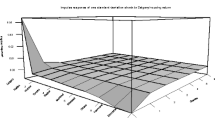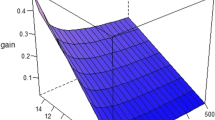Abstract
We estimate location values for single family houses using a standard house price and characteristics dataset and local polynomial regressions (LPR), a procedure that allows for complex interactions between the values of structural characteristics and the value of land. We also compare LPR to additive OLS models in the Denver metropolitan area with out-of-sample methods. We determine that the LPR model is more efficient than OLS at predicting location values in counties with greater densities of sales. Also, LPR outperforms OLS in 2010 for all counties in our dataset. Our findings suggest that LPR is a preferable approach in areas with greater concentrations of sales and in periods of recovery following a financial crisis.








Similar content being viewed by others
Notes
For example, Diamond (1980) stressed that the price of urban residential land depended primarily on location features and amenities.
Throughout the paper, we use the terms land prices and location values interchangeably. Location value highlights that, as suggested by theory, the right to build at a specific location commands a price.
They estimate that the average ratio of land value to total residential property value is 32 %, a fraction that has been increasing over time.
For example, Saiz (2010) summarizes the model common to all these papers. “Recall from the model that, on the supply side, average housing prices in a city are the sum of construction costs plus land values (themselves a function of the number of housing units) (p. 1266).”
Likewise, Longhofer and Redfearn (2009) use vacant land sales and their heterogeneous characteristics to estimate the level of land values at various points within Witchita, Kansas. But unlike Kok et al. (2014), a large part of the variation in their estimates of land values comes from variation in the implicit prices of structural characteristics.
In the context of commercial real estate, Haughwout et al. (2008) estimate land prices using a dataset that includes purchases of vacant land as well as plots with unoccupied structures slated for demolition and subsequent replacement by new constructions.
Davis and Palumbo (2008) decompose property value into structure and land components, and find significant changes in land value over time and across metropolitan areas. They subtract the cost of construction from sales prices, while we use the implicit value of the structure.
The natural log of sales price is the dependent variable because logarithms control for heteroscedasticity and some nonlinearity, and enhance degrees of freedom. Hastie and Tibshirani (1990), pp. 52–55, discuss degrees of freedom for smoothing models.
Of course, a nonlinear relationship (e.g., with building age) is typically modeled with a quadratic term.
Some, such as Davis and Palumbo (2008), have suggested that location value should be estimated as property value less construction costs. To get to this quantity, one would add back \( {Z}_{\mathrm{i}}{\overset{\wedge }{\alpha}}_R \) and then subtract construction costs. An approximation to construction costs can be obtained by assuming that they are invariant within the metropolitan area and that they change slowly over time as the costs of material and labor change, and therefore the level of construction costs at time zero is the same for all properties in the city. The Marshall Valuation Service (MVS) is one approach to approximation of this level. Then percentage changes over time can be approximated by using a construction cost indexes such as those published by Engineering News-Record (ENR, http://enr.construction.com/economics/ ). With these adjustments, location value is estimated by:
$$ \widehat{q}\left({\mathrm{S}}_i,{t}_i\right)+{Z}_i{\overset{\wedge }{\alpha}}_R-{C}_{it} $$where C it is an estimate of construction costs for house i in year t. This procedure may be considered as a robustness check.
We subsequently estimate a separate hedonic equation, alongside separate Robinson Coefficients, for each of the five counties in each of 2003, 2006, and 2010. This full set of estimation results is available from the authors upon request.
The tables of these results for each county in each year are available from the authors upon request.
Lower Robinson coefficients for land area are plausibly related to the LPR model of location value. An extra square foot of land is an amenity which should not be highly priced given that permission has been granted to build at that location. Small lots that constrain building size are an exception to this rule; evidence supporting this exception is presented in Clapp and Salavei (2010).
Figures containing the location values for the other three counties are available from the authors upon request. We use Jenks natural breaks classification method, which does not require the same number of observations in each value interval. The objective of the Jenks natural breaks classification method (as described on the ESRI website: http://www.esri.com/industries/k-12/education/~/media/files/pdfs/industries/k-12/pdfs/intrcart.pdf) is to reduce variance within groups and maximize variance between groups. More generally, this is done by seeking to minimize each interval’s average deviation from the interval mean, while maximizing each interval’s deviation from the means of the other intervals. We found that conclusions using Jenks are not dramatically different than the quintile method, which does require an equal number of observations in each value interval.
Note that each figure reveals relative land values over space in a given year using the Jenks natural breaks classification method. The levels of land values cannot be compared across years because we have not modeled time other than by separating the sample into annual cohorts.
This issue was pointed out to us by Kelley Pace.
References
Bourassa, S. C., Hoesli, M., Scognamiglio, D., & Zhang, S. (2011). Land leverage and house prices. Regional Science and Urban Economics, 41, 134–144.
Brasington, D., & Haurin, D. R. (2006). Educational outcomes and house values: a test of the value added approach. Journal of Regional Science, 46, 245–268.
Clapp, J. M. (2004). A Semiparametric method for estimating local house price indices. Real Estate Economics, 32, 127–160.
Clapp, J. M., & Salavei, K. (2010). Hedonic pricing with redevelopment options: a new approach to estimating depreciation effects. Journal of Urban Economics, 67, 362–377.
Clapp, J. M., Jou, J. B., & Lee, T. (2012). Hedonic models with redevelopment options under uncertainty. Real Estate Economics, 40(2), 197–216.
Cohen, J. P., Coughlin, C. C., & Lopez, D. A. (2012). The boom and bust of U.S. housing prices from various geographic perspectives. Federal Reserve Bank of St. Louis Review, 94, 341–368.
Cohen, J. P., Coughlin, C. C., Lopez, D. A., Clapp, J. M. (2013). Estimation of Airport Infrastructure Capitalization for Land Value Capture Purposes. Working Paper WP13JC2, Lincoln Institute of Land Policy.
Cohen, J. P., Coughlin, C. C., Clapp, J. M. (2014). Semi-Parametric Interpolations of Residential Location Values: Using Housing Price Data to Generate Balanced Panels. Working Papers 2014–50, Federal Reserve Bank of St. Louis.
Davis, M. A., & Heathcote, J. (2007). The price and quantity of residential land in the United States. Journal of Monetary Economics, 54, 2595–2620.
Davis, M. A., & Palumbo, M. G. (2008). The price of residential land in large US cities. Journal of Urban Economics, 63, 352–384 Data located at Land and Property Values in the U.S., Lincoln Institute of Land Policy. Available at: http://www.lincolninst.edu/resources/.
Diamond, D. B. (1980). The relationship between amenities and urban land prices. Land Economics, 56, 21–32.
Dye, R. F., & McMillen, D. P. (2007). Teardowns and land values in the Chicago metropolitan area. Journal of Urban Economics, 61, 45–64.
Fik, T. J., Ling, D. C., & Mulligan, G. F. (2003). Modelling spatial variation in housing prices: a variables interaction approach. Real Estate Economics, 31(4), 623–646.
Gibbons, S., Machin, S., & Silva, O. (2013). Valuing school quality using boundary discontinuities. Journal of Urban Economics, 75, 15–28.
Gloudemans, R. J., Handel, S., Warwa, M. (2002). An empirical evaluation of alternative land valuation models. Lincoln Institute of Land Policy.
Hastie, T. J., Tibshirani, R. J. (1990). Generalized additive models. Chapman & Hall/CRC Monographs on Statistics & Applied Probability.
Haughwout, A., Orr, J., & Bedoll, D. (2008). The price of land in the New York metropolitan area. Federal Reserve Bank of New York Current Issues in Economics and. Finance, 14, 1–7.
Hendriks, D. (2005). Apportionment in property valuation: should we separate the inseparable? Journal of Property Investment & Finance, 23, 455–470.
Kok, N., Monkkonen, P., & Quigley, J. M. (2014). Land use regulations and the value of land and housing: an intra-metropolitan analysis. Journal of Urban Economics, 81, 136–148.
Longhofer, S. D., Redfearn, C. L. (2009). Estimating Land Values Using Residential Sales Data. Working Paper WP09SL1, Lincoln Institute of Land Policy.
Nichols, J. B., Oliner, S. D., & Mulhall, M. R. (2013). Swings in commercial and residential land prices in the United States. Journal of Urban Economics, 73, 57–76.
Ozdilek, U. (2012). An overview of the enquiries on the issue of apportionment of value between land and improvements. Journal of Property Research, 29, 69–84.
Saiz, A. (2010). The geographic determinants of housing supply. Quarterly Journal of Economics, 125, 1253–1296.
Sirmans, C. F., & Slade, B. A. (2012). National Transaction-Based Land Price Indices. Journal of Real Estate Finance and Economics, 45, 829–845.
Titman, S. (1985). Urban land prices under uncertainty. The American Economic Review, 75(3), 505–514.
Author information
Authors and Affiliations
Corresponding author
Additional information
The authors appreciate the assistance of Brett Fawley, David Lopez, Diana Cooke, Jonas Crews, and Lowell Ricketts. Participants in the U Conn Center for Real Estate 50th Anniversary Symposium and at the NARSC 2014 Annual Meetings provided helpful comments on prior versions of the manuscript. Clapp and Cohen acknowledge support from the Center for Real Estate, University of Connecticut. The views expressed are those of the authors and do not necessarily reflect official positions of the Federal Reserve Bank of St. Louis, the Federal Reserve System, or the Board of Governors.
An erratum to this article is available at http://dx.doi.org/10.1007/s11146-017-9604-5.
Rights and permissions
About this article
Cite this article
Cohen, J.P., Coughlin, C.C. & Clapp, J.M. Local Polynomial Regressions versus OLS for Generating Location Value Estimates. J Real Estate Finan Econ 54, 365–385 (2017). https://doi.org/10.1007/s11146-016-9570-3
Published:
Issue Date:
DOI: https://doi.org/10.1007/s11146-016-9570-3




